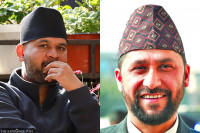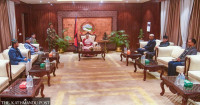Politics
KP Oli boosts UML’s digital campaigning
Other party leaders admit to being behind the UML in the digital-campaign race.
Anil Giri
The digitalization of election campaigns is slowly taking away the traditional methods of campaigning such as the distribution of pamphlets, posters, door-to-door campaigns, corner meetings and placing of banners and graffiti.
As the date for elections to the federal and provincial assemblies draws closer, the political parties and candidates are venturing aggressively into election campaigns on digital platforms—and the trend has only accelerated from the last elections held in 2017.
The largest party, CPN-UML, is currently beating other political parties in digital election campaigns, its competitors said.
Those in-charge of publicity departments of parties said digital campaigns have become more common due to wide availability of the internet and smartphones. They help parties understand voter-pulse with minimal investment.
Political parties and individual candidates are campaigning on various social media platforms like Facebook, Twitter, Instagram, Tiktok, Whatsapp, Viber, Linkedin, Telegram and Youtube.
Dipesh Bista, the in-charge of the digital wing of the Nepali Congress, admits that UML is currently ahead of the Congress in terms of publicity and campaigning on digital platforms.
One UML leader told the Post that their party’s aggressive election campaign on digital platforms owes to the tech-savvy of party chairman, KP Sharma Oli.
“Our Chairman is on Facebook, Twitter and Tiktok, and he updates and uploads the content and directly connects with his followers,” the UML leader said. “That is why the party places such high emphasis on the digital campaign.”
He said the UML has developed a separate mobile app for the party, where its activities are regularly updated. The party has also been updating its activities on social media platforms like Facebook and Twitter.
“Chairman Oli even unveiled the party’s manifesto, digitally, on November 1, the first of its kind experiment by a Nepali politician. Along with the digital unveiling, the party released a video of its achievements while in the government. As of now, no other party in Nepal has launched or unveiled their party manifesto digitally,” the CPN-UML leader added.
Bishnu Rijal, deputy head of the CPN-UML’s publicity division, said they are a small team who are working tirelessly towards making their election campaign digital-friendly.
“We develop some content from the centre [party headquarters] and upload them on various social media platforms. In other cases, the candidates themselves as well as the party’s well-wishers are involved in preparing the digital content,” he added.
While the video, which was broadcast while unveiling the election manifesto was prepared outside, most materials related to the election campaigns are being prepared by the candidates themselves, district party committees and party well-wishers, Rijal said. “The response is positive and we have been able to reach out to voters living both inside and outside the country.”
The UML has allocated a separate fund for creating various social media and digital content, said the UML leader. Besides, individual leaders and party well-wishers are also spending their own money to create social media content.
The Congress, meanwhile, has formed a digital team and is updating election-related content on social media. The individual Congress candidates are updating their own content on social media.
“The UML is aggressive on digital platforms as campaigning there is mostly free and not under government control,” said Bista, who heads the Congress information and communication cell. He admitted that Oli’s direct interest and intervention on social media might be working in UML’s favour.
“Oli runs his own page on Facebook and regularly shares content. He prepares [videos] for Tiktok too. That makes a difference,” said Bista.
Other parties like the CPN (Maoist Center), the CPN (Unified Socialist), the Janata Samajbadi Party and the Loktantrik Samajbadi Party have less of a presence on social media. But some independent candidates and those contesting on the tickets of the Rastriya Swatantra Party, the Hamro Nepali Party and the Bibeksheel Party are among those campaigning aggressively on social media.
Sambhu Shrestha, who is the deputy head of the publicity department of the Unified Socialist, said that their party is not venturing much on digital platforms.
“We are not like the UML which can spend huge amounts on digital publicity and campaigning,” said Shrestha.
There are two different kinds of publicity on digital platforms. One is the sponsored content splashed across social media sites and the second is updating regular content without paying any fee to social media platforms.
In their social media posts, the Congress and UML have each highlighted the achievements of the governments they led, in addition to outlining their future priorities and objectives.
Meanwhile, the Elections Commission has for the upcoming elections reached an agreement with Meta, the parent company of Facebook, whereby it will get details of candidate-expenditures on Facebook, Instagram and two other websites Meta owns, according to Salikgram Poudel, the spokesperson for the Election Commission.
“The candidates will also have to account for the unsponsored content after the elections,” Poudel added.
He said the commission is trying to reach out to other social media platforms as well in order to get a more accurate picture of the expenditures by individual candidates.
As of Tuesday, according to the Facebook Library Report, Suresh Basnet of the Nepali Congress had spent $1,523 on sponsored content on Facebook. Similarly, an independent candidate, Shree Gurung had spent $1,385, Sushant Shrestha, another independent candidate from Kathmandu, had spent $1,006. Meanwhile, Ganesh Parajuli of the Rastriya Swatantra Party paid for $720-worth of sponsored content on Facebook.




 19.12°C Kathmandu
19.12°C Kathmandu


.jpg&w=200&height=120)












